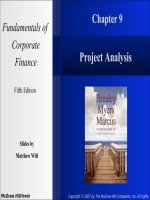Fundamentals of corporate finance 5e mcgraw chapter 08
Bạn đang xem bản rút gọn của tài liệu. Xem và tải ngay bản đầy đủ của tài liệu tại đây (382.86 KB, 15 trang )
Fundamentals of
Corporate
Finance
Chapter 8
Using Discounted Cash Flow
Analysis to Make Investment
Decisions
Fifth Edition
Slides by
Matthew Will
McGraw-Hill/Irwin
Copyright © 2007 by The McGraw-Hill Companies, Inc. All rights reserved
8- 2
Topics Covered
Identifying Cash Flows
Discounted
Cash Flows, Not Profits
Incremental Cash Flows
Treatment of Inflation
Separate Investment & Financing Decisions
Calculating Cash Flows
Example: Blooper Industries
McGraw-Hill/Irwin
Copyright © 2007 by The McGraw-Hill Companies, Inc. All rights reserved
8- 3
Cash Flow vs. Accounting Income
Discount actual cash flows
Using accounting income, rather than cash flow,
could lead to erroneous decisions.
Example
A project costs $2,000 and is expected to last 2
years, producing cash income of $1,500 and $500
respectively. The cost of the project can be
depreciated at $1,000 per year. Given a 10% required
return, compare the NPV using cash flow to the NPV
using accounting income.
McGraw-Hill/Irwin
Copyright © 2007 by The McGraw-Hill Companies, Inc. All rights reserved
8- 4
Cash Flow vs. Accounting Income
Cash Income
Depreciation
Accounting Income
Year 1
Year 2
$1500
$ 500
- $1000 - $1000
+ 500
- 500
500
− 500
Apparent NPV =
+
= $41.32
2
1.10 (1.10)
McGraw-Hill/Irwin
Copyright © 2007 by The McGraw-Hill Companies, Inc. All rights reserved
8- 5
Cash Flow vs. Accounting Income
Today
Cash Income
Project Cost
Free Cash Flow
- 2000
- 2000
Year 1 Year 2
$1500 $ 500
+1500
+ 500
- 2000 1500
500
Cash NPV =
+
+
= −$223.14
2
3
1.10 (110
. )
(110
. )
McGraw-Hill/Irwin
Copyright © 2007 by The McGraw-Hill Companies, Inc. All rights reserved
8- 6
Incremental Cash Flows
Discount incremental cash flows
Include All Indirect Effects
Forget Sunk Costs
Include Opportunity Costs
Recognize the Investment in Working Capital
Beware of Allocated Overhead Costs
Incremental
Cash Flow
McGraw-Hill/Irwin
=
cash flow
with project
-
cash flow
without project
Copyright © 2007 by The McGraw-Hill Companies, Inc. All rights reserved
8- 7
Incremental Cash Flows
IMPORTANT
Ask yourself this question
Would the cash flow still exist if the project
does not exist?
If yes, do not include it in your analysis.
If no, include it.
McGraw-Hill/Irwin
Copyright © 2007 by The McGraw-Hill Companies, Inc. All rights reserved
8- 8
Inflation
INFLATION RULE
Be consistent in how you handle inflation!!
Use nominal interest rates to discount
nominal cash flows.
Use real interest rates to discount real cash
flows.
You will get the same results, whether you
use nominal or real figures
McGraw-Hill/Irwin
Copyright © 2007 by The McGraw-Hill Companies, Inc. All rights reserved
8- 9
Inflation
Example
You own a lease that will cost you $8,000 next
year, increasing at 3% a year (the forecasted
inflation rate) for 3 additional years (4 years
total). If discount rates are 10% what is the
present value cost of the lease?
1+nominal interest rate
1 + real interest rate =
1+inflation rate
McGraw-Hill/Irwin
Copyright © 2007 by The McGraw-Hill Companies, Inc. All rights reserved
8- 10
Inflation
Example - nominal figures
Year Cash Flow
PV @ 10%
0
8000
8,000.00
1
8000x1.03 = 8,240
2
8000x1.032 = 8,487.20
8240
1.10
8487.20
1.10 2
8741.82
1.103
3
3
8000x1.03 = 8,741.82
= 7,490.91
= 7,014.22
= 6,567.86
$29,072.98
McGraw-Hill/Irwin
Copyright © 2007 by The McGraw-Hill Companies, Inc. All rights reserved
8- 11
Inflation
Example - real figures
Year
0
1
2
3
McGraw-Hill/Irwin
Cash Flow
8,000
8,000
8,000
8,000
%
8,000
8,000
=
7,490.91
1.068
8,000
= 7,014.22
1.068 2
8,000
3 = 6,567.86
1.068
= $ 29,072.98
Copyright © 2007 by The McGraw-Hill Companies, Inc. All rights reserved
8- 12
Separation of Investment &
Financing Decisions
When valuing a project, ignore how the
project is financed.
Following the logic from incremental
analysis ask yourself the following
question: Is the project existence dependent
on the financing? If no, you must separate
financing and investment decisions.
McGraw-Hill/Irwin
Copyright © 2007 by The McGraw-Hill Companies, Inc. All rights reserved
8- 13
Blooper Industries
Year 0
Cap Invest
10,000
WC
1,500
Change in WC 1,500
Revenues
Expenses
Depreciation
Pretax Profit
.Tax (35%)
Profit
1
2
3
4
5
6
4,075
2,575
15,000
10,000
2,000
3,000
1,050
1,950
4,279
204
15,750
10,500
2,000
3,250
1137
,
2,113
4,493
214
16,538
11,025
2,000
3,513
1,230
2,283
4,717
225
17,364
11,576
2,000
3,788
1,326
2,462
3,039
− 1,678
18,233
12,155
2,000
4,078
1,427
2,651
0
− 3,039
(,000s)
McGraw-Hill/Irwin
Copyright © 2007 by The McGraw-Hill Companies, Inc. All rights reserved
8- 14
Blooper Industries
Cash Flow From Operations (,000s)
Revenues
- Expenses
15,000
10,000
− Depreciation
= Profit before tax
2,000
3,000
.-Tax @ 35 %
1,050
= Net profit
+ Depreciation
1,950
2,000
= CF from operations
3,950
McGraw-Hill/Irwin
or $3,950,000
Copyright © 2007 by The McGraw-Hill Companies, Inc. All rights reserved
8- 15
Blooper Industries
Net Cash Flow (entire project) (,000s)
Year 0
- 10,000
Cap Invest
Salvage value
Change in WC
- 1,500
CF from Op
Net Cash Flow - 11,500
1
- 2,575
3,950
1,375
2
- 204
4,113
3,909
3
- 214
4,283
4,069
4
- 225
4,462
4,237
5
1,678
4,651
6,329
6
1,300
3,039
4,339
NPV @ 12% = $4,222,350
McGraw-Hill/Irwin
Copyright © 2007 by The McGraw-Hill Companies, Inc. All rights reserved









